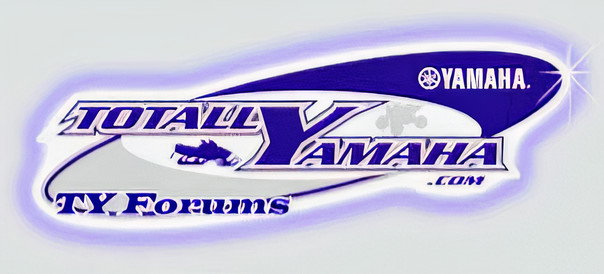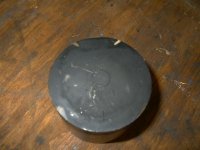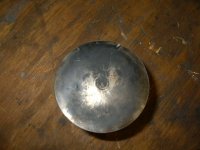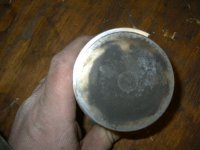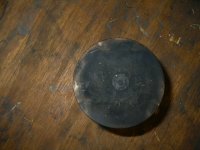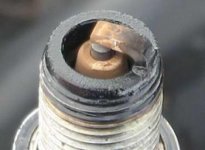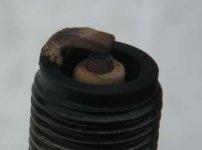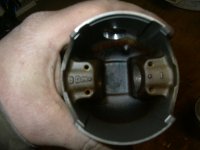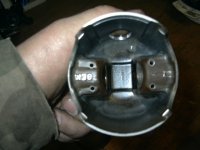How to jet a snowmobile and read the plugs and piston wash:
This is another example of something that people ask for all the time and is quite easy to do themselves. When jetting a sled your going to be working in steps, first will be the low speed circuit, this involves the pilot jet and the fuel screw settings.
1.) Low speed circuits: With the correct pilot jet and fuel screw settings the sled will smoothly gain rpm and not cough back thru the carbs or backfire thru the exhaust, it will cleanly gain rpm from a dead hit off idle.
A.)Too much pilot jet will result in overly rich idle, fouling plugs and "wet" looking plugs. The piston top will be washed clean of carbon and be a new like silver color. Anytime you clutch a sled very aggressively and or make motor mods you most likely will need to richen up the low speed circuits, this can be from simply turning out the fuel screws more or bumping up the pilot jet size. Again your looking for good clean stabil idle and dry plugs.
(Rule of thumb)- if you need more then 2 turns out on the fuel screws to have a stabil idle speed and smooth rpm gain, you need to bump up to the next biggest pilot jet.
2.) Needles:This next step will be where you need to ride the sled for a distance, because the carb circuits all overlap and it takes a bit of distance to get the circuit you want to tune to be free of the overlapping circuits. The needles are where most all people tend to overlook, its also one of the biggest reasons why people burn down their newly piped viper,big bore srx/viper engines, modded engines etc. The needle circuit overlaps with your low speed circuit we discussed above, it controls from 3/8-5/8 throttle settings, your mid range cruising speeds.
To check your needle circuit you need to take the sled to a open field and run it at half throttle for a good 500-600ft, steady throttle and then with your left hand, reach over your hand holding the throttle open and hit the kill switch. Keep the throttle at the same exact opening till sled coast to a stop. Remove the plugs and observe the burn on the electrode, ground strap and porcelin insulator, then observe the piston dome, it should be somewhat dry,slightly black/brown appearing and have no signs of detonation on the edge(little pick marks)
Needle tuning tip: There are 2 little white plastic washers in your carbs, these will stick to the slide and to the mounting block,so be carefull to not lose them or neglect installing them correctly. They will allow you to place the needle in a half clip spot, by either shimming under the clip or on top of the clip, this allows you to super fine tune the needle settings for crisp performance and perfect mixtures.
3.) Main jet circuit: Lastly youll need to adjust your main jet size, this jet is what everyone thinks can keep an engine from blowing up but actually the needle is far more important in a trail sled where steady speeds(midrange) are held for long periods of time, so dont skip the needle!!!
This jet controls the 3/4-wide open throttle settings, it is responsible for the coloring of the piston/plug on long runs over 600-700ft, you wont be completely on the main jet till after 500ft, the carb circuits all overlap and it takes a bit to get completely on the main. The pilotjet you tuned earlier also does contribute to a small 2-3% total fuel flow even at wideopen. I have posted pics below to show you differnt piston tops to help guide you on the coloring of them and what a sparkplug should look like if you get all 3 circuits tuned in perfect. I also will add some pics of differnt plugs as I do tuning here in the field to show you so check back to see more plug pics in various stages.
In closing there is actaully alot more things to look for in a finely tuned race sled or if you want to at your best for the weekend grudge match on the lake. There is a hidden indicator that you can look at if you happen to be freshning up your engine, if you look to the underside of thepiston dome youll see a indicator of how well you have jetted your engine overtime. The perfect looking underside dome will be a dark hershy bar brown and about the size of a dime or nickel, this means you have the optimum mixture,temp in the piston to make good power. If its large and filling entire dome top and flakey black its too rich and also too rich in the way of oil/fuel ratio. If you see the underside is a grey/whiteish color and dry, its called "death ash", you can guess as to how it gots its name, this will be shown in a blown up seized engine on a lake run.
If you place your cursor over the pic, it will identify the number:
Pic# 33= Good wash, very good overall jetted trail riding piston
Pic #34= slightly lean, you can see the dryness and the piston top wont color its whole surface, this is where the sled will feel "flat" just like its making noise and not gaining speed.
Pic #35-Detonation starting, the pic is bad or youd also be able to see the spotting on the ringlands, its best described as looking like you washed your car and the sun made waterspots on it, the ring tops will look just like spotted car, this is the first sign of too lean. The edge of the piston also gets a small picked looking appearance to it, best described as little ice pick indentations on the squishband edge of the piston, too low of octane and or lean jetting contribute to this.
Pic #36- Too much oil and rich, too much carbon build up top and little wash marks(clean spots from swirl of transfer ports on dome edges), You cant tell from the pic but the carbon has begun to stack up in the dome, layered effect. This is usually how a stock jetted sled will appear. A piston can be even richer then this but will be a wet, silver(no color), this piston is as close to a stocker as I had on hand to show an example.Its not the most prime example but a pretty close one.
This is another example of something that people ask for all the time and is quite easy to do themselves. When jetting a sled your going to be working in steps, first will be the low speed circuit, this involves the pilot jet and the fuel screw settings.
1.) Low speed circuits: With the correct pilot jet and fuel screw settings the sled will smoothly gain rpm and not cough back thru the carbs or backfire thru the exhaust, it will cleanly gain rpm from a dead hit off idle.
A.)Too much pilot jet will result in overly rich idle, fouling plugs and "wet" looking plugs. The piston top will be washed clean of carbon and be a new like silver color. Anytime you clutch a sled very aggressively and or make motor mods you most likely will need to richen up the low speed circuits, this can be from simply turning out the fuel screws more or bumping up the pilot jet size. Again your looking for good clean stabil idle and dry plugs.
(Rule of thumb)- if you need more then 2 turns out on the fuel screws to have a stabil idle speed and smooth rpm gain, you need to bump up to the next biggest pilot jet.
2.) Needles:This next step will be where you need to ride the sled for a distance, because the carb circuits all overlap and it takes a bit of distance to get the circuit you want to tune to be free of the overlapping circuits. The needles are where most all people tend to overlook, its also one of the biggest reasons why people burn down their newly piped viper,big bore srx/viper engines, modded engines etc. The needle circuit overlaps with your low speed circuit we discussed above, it controls from 3/8-5/8 throttle settings, your mid range cruising speeds.
To check your needle circuit you need to take the sled to a open field and run it at half throttle for a good 500-600ft, steady throttle and then with your left hand, reach over your hand holding the throttle open and hit the kill switch. Keep the throttle at the same exact opening till sled coast to a stop. Remove the plugs and observe the burn on the electrode, ground strap and porcelin insulator, then observe the piston dome, it should be somewhat dry,slightly black/brown appearing and have no signs of detonation on the edge(little pick marks)
Needle tuning tip: There are 2 little white plastic washers in your carbs, these will stick to the slide and to the mounting block,so be carefull to not lose them or neglect installing them correctly. They will allow you to place the needle in a half clip spot, by either shimming under the clip or on top of the clip, this allows you to super fine tune the needle settings for crisp performance and perfect mixtures.
3.) Main jet circuit: Lastly youll need to adjust your main jet size, this jet is what everyone thinks can keep an engine from blowing up but actually the needle is far more important in a trail sled where steady speeds(midrange) are held for long periods of time, so dont skip the needle!!!
This jet controls the 3/4-wide open throttle settings, it is responsible for the coloring of the piston/plug on long runs over 600-700ft, you wont be completely on the main jet till after 500ft, the carb circuits all overlap and it takes a bit to get completely on the main. The pilotjet you tuned earlier also does contribute to a small 2-3% total fuel flow even at wideopen. I have posted pics below to show you differnt piston tops to help guide you on the coloring of them and what a sparkplug should look like if you get all 3 circuits tuned in perfect. I also will add some pics of differnt plugs as I do tuning here in the field to show you so check back to see more plug pics in various stages.
In closing there is actaully alot more things to look for in a finely tuned race sled or if you want to at your best for the weekend grudge match on the lake. There is a hidden indicator that you can look at if you happen to be freshning up your engine, if you look to the underside of thepiston dome youll see a indicator of how well you have jetted your engine overtime. The perfect looking underside dome will be a dark hershy bar brown and about the size of a dime or nickel, this means you have the optimum mixture,temp in the piston to make good power. If its large and filling entire dome top and flakey black its too rich and also too rich in the way of oil/fuel ratio. If you see the underside is a grey/whiteish color and dry, its called "death ash", you can guess as to how it gots its name, this will be shown in a blown up seized engine on a lake run.
If you place your cursor over the pic, it will identify the number:
Pic# 33= Good wash, very good overall jetted trail riding piston
Pic #34= slightly lean, you can see the dryness and the piston top wont color its whole surface, this is where the sled will feel "flat" just like its making noise and not gaining speed.
Pic #35-Detonation starting, the pic is bad or youd also be able to see the spotting on the ringlands, its best described as looking like you washed your car and the sun made waterspots on it, the ring tops will look just like spotted car, this is the first sign of too lean. The edge of the piston also gets a small picked looking appearance to it, best described as little ice pick indentations on the squishband edge of the piston, too low of octane and or lean jetting contribute to this.
Pic #36- Too much oil and rich, too much carbon build up top and little wash marks(clean spots from swirl of transfer ports on dome edges), You cant tell from the pic but the carbon has begun to stack up in the dome, layered effect. This is usually how a stock jetted sled will appear. A piston can be even richer then this but will be a wet, silver(no color), this piston is as close to a stocker as I had on hand to show an example.Its not the most prime example but a pretty close one.
Attachments
Last edited by a moderator:
Saprk plugs
sparkplug observation: theres 2 pics here, (LEFT) is a right on the money spot on jetting, but this would leave you not very much room if there were a temp drop in the night, but you can clearly see the center elctrode of the plug siver across the tip, the ground strap is burned halfway back into the curve, the porcelin has a nice brown finish to it, if the plug would have been newer instead of a used plug youd see the porcelin white with a "smoke ring" about half the way down it, this means your in the sweet spot! Also, if your running octane booster it will show up on the porcelin with a rusty red finish! Race gas will make the plugs a dull grey color and very hard to read, thats why youd need to cut the race gas with some pumpgas to get some "coloring" on the plug to be able to accurately read it.
The other pic (right) is of a trail friendly plug with a small bit of safety in there for a temp drop at night. If the same charactoristics from the spot on plug are seen but the center elctrode core is just silver on the outside edge, with a darker to black center on it, you have a little bit of safety margin in there, this is a excellant trail sparkplug and will yield excellant power from the sled. The first plug is what I would want when I am racing.( Remember the center will be more white if a NEW sparkplug is used then a old trail ridden one)
sparkplug observation: theres 2 pics here, (LEFT) is a right on the money spot on jetting, but this would leave you not very much room if there were a temp drop in the night, but you can clearly see the center elctrode of the plug siver across the tip, the ground strap is burned halfway back into the curve, the porcelin has a nice brown finish to it, if the plug would have been newer instead of a used plug youd see the porcelin white with a "smoke ring" about half the way down it, this means your in the sweet spot! Also, if your running octane booster it will show up on the porcelin with a rusty red finish! Race gas will make the plugs a dull grey color and very hard to read, thats why youd need to cut the race gas with some pumpgas to get some "coloring" on the plug to be able to accurately read it.
The other pic (right) is of a trail friendly plug with a small bit of safety in there for a temp drop at night. If the same charactoristics from the spot on plug are seen but the center elctrode core is just silver on the outside edge, with a darker to black center on it, you have a little bit of safety margin in there, this is a excellant trail sparkplug and will yield excellant power from the sled. The first plug is what I would want when I am racing.( Remember the center will be more white if a NEW sparkplug is used then a old trail ridden one)
Attachments
Last edited by a moderator:
Another Great post! Printed out so I can always refer to this!
Inside the piston dome
This is the hidden indicator of how well your tuned in! Small sized brownish spot, means very good tune-(pic 42), a large coloring,black,flakey means rich and too much oil as well(pic-41). (Move your cursor over pic to identify the number)
Differnt oils can affect this though, yamalube will burn black and bone dry, synthetic oils will be more wet and brown in color.
This is the hidden indicator of how well your tuned in! Small sized brownish spot, means very good tune-(pic 42), a large coloring,black,flakey means rich and too much oil as well(pic-41). (Move your cursor over pic to identify the number)
Differnt oils can affect this though, yamalube will burn black and bone dry, synthetic oils will be more wet and brown in color.
Attachments
Vector88
New member
very nice post mrviper700!!! ill be looking at this for sure when i pipe my viper! this will help me alot!
Just an awesome post!!! Descriptive, detailed and with pics no less! Thank you mrviper700!
Show the underside of a slightly lean piston if you have one Don.
Usually there are other signs if it is lean, but I have seen pistons that looked good on top, but underneath you could tell that they were in the danger zone.
Usually there are other signs if it is lean, but I have seen pistons that looked good on top, but underneath you could tell that they were in the danger zone.
- Status
- Not open for further replies.
